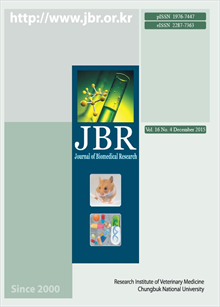간행물
Journal of Biomedical Research

- 발행기관 충북대학교 동물의학연구소
- 자료유형 학술지
- 간기 계간
- ISSN 1976-7447 (Print)2287-7363 (Online)
- 수록기간 2000 ~ 2015
- 주제분류 의약학 > 수의학 의약학 분류의 다른 간행물
- 십진분류KDC 528DDC 636
권호리스트/논문검색
Vol. 9 No. 1 (2008년 3월) 6건
1.
2008.03
구독 인증기관 무료, 개인회원 유료
Vascular endothelial growth factor (VEGF) was a main substance as an endothelial cell specific mitogen. This acts sometimes as an antiapoptotic factor. It plays an important role in the embryo development as well as implantation process. This review introducesthe function and distribution of the VEGF and its receptors related to the development of mammal embryos.
4,000원
2.
2008.03
구독 인증기관 무료, 개인회원 유료
This study was carried out to evaluate the genotoxicity of the gamma-irradiated (0, 5 and 10 kGy) milk and ice cream. The Salmonella typhimurium reversion assay was performed using S. typhimurium TA98, TA100, TA102, TA1535 and TA1537 as tester strains. The number of revertant colonies were not increased in both milk and ice cream, compared with negative controls with or without metabolic activation. There were no significant differences among the irradiation doses. These results indicate that the gamma-irradiated milk and ice cream do not show any genotoxic effect under these experimental conditions, and that they may be safe genotoxically.
4,000원
3.
2008.03
구독 인증기관 무료, 개인회원 유료
The insecticidal potency of some essential oils have been suggested that they may find an application in the control of house dust mites. We compared the repellent effect of four essential oils ; lemon grass (Cymbopogon nardus), lavender(Lavandula vera), rosemary(Rosmarinus officinalis) and ylang ylang(Cananga odorata). The oils were exposed at different doses(0.1, 0.05, 0.025, 0.0125, and 0.00652 ㎕/㎠) and different times(1, 2, 3, 4, 5 hours) on house dust mites(Dermatophagoides farinae and D. pteronyssinus). The repellent effects(%) of essential oils that were exposed at 0.1 ㎕/㎠ and for 1 hours against house dust mites were lemon grass(63.3%) and rosemary(61%), lavender(40%), ylang ylang(40%) in the order named.
4,000원
4.
2008.03
구독 인증기관 무료, 개인회원 유료
In the present study, we have demonstrated that a novel synthetic chemical JSH-21 of N¹-Benzyl-4-methylbenzene-1,2-diamine could inhibit nitric oxide (NO) production in lipopolysaccharide (LPS)-activated macrophages RAW 264.7. The JSH-21 showed an IC50 value of 9.2 uM on the LPS-induced NO production. Furthermore, JSH-21 attenuated LPS-induced mRNA and protein levels of inducible NO synthase (iNOS) in the cells, as well as inhibited LPS-induced iNOS promoter activity. These results indicates hat the compound could down-regulate iNOS expression at the transcription level. Since NF-kB activation is a key mechanism in the expression of LPS-inducible iNOS gene, we further examined whether JSH-21 could affect LPS-induced NF-kB activation. JSH-21 inhibited LPS-induced nuclear import of NF-kB p65 in macrophages RAW 264.7 and sequentially prevented NF-kB transcriptional activity. However, JSH-21 was not effective in a LPS-induced degradation of cytoplasmic IkB-alpha in the cells. These results suggest that JSH-21 could inhibit LPS-induced NF-kB activation targeting nuclear import of NF-kB, an event downstream IkB degradation. Taken together, this study may provide a pharmacological potential of JSH-21 in the NO- or NF-kB-associated inflammatory disorders.
4,000원
5.
2008.03
구독 인증기관 무료, 개인회원 유료
Acute lymphoblastic leukemia (ALL), a predominantly pediatric disease involving uncontrolled proliferation of white blood cells within the bone marrow, is strongly associated with chromosomal translocations. The human chromosomal translocation t(12;21)(p12;q22) is the most frequently encountered chromosomal rearrangement in pediatric B-lineage ALL, and results in fusion of the TEL and RUNX1 genes. The resulting TEL/RUNX1 fusion protein is generally thought to be a transcriptional repressor that interferes with RUNX1-mediated transactivation. We used a luciferase assay system to investigate the effects of TEL/RUNX1 and PEBP2β on RUNX1-mediated transactivation. TEL/RUNX1 blocked the synergistic transactivation achieved by PEBP2β and RUNX1, and coimmunoprecipitation and immunofluorescence analyses showed that PEBP2β interacted with TEL/RUNX1 and was sequestered in the cytoplasm. Theses results suggest that TEL/RUNX1 inhibits RUNX1-mediated transactivtion via cytoplasmic sequestration of coactivator(s) such as PEBP2β.
4,000원
6.
2008.03
구독 인증기관 무료, 개인회원 유료
A two-month-old male calf weighing 70 kg with congenital metacarpophalangeal flexural deformity was referred to the Veterinary Medical Center of Chugbuk National University. The calf could not stand and walk normally that walked with the dorsal surface of the hoof with contraction of fetlock joint. The both forelimbs had been casted two times during 45 days before presentation. Midline of the palmar surface of the feltlock joint was incised to cut superficial flexor tendon, deep flexor tendon and interosseus muscle. Both forelimbs are healed well returned to normal function after tenotomy.
4,000원

